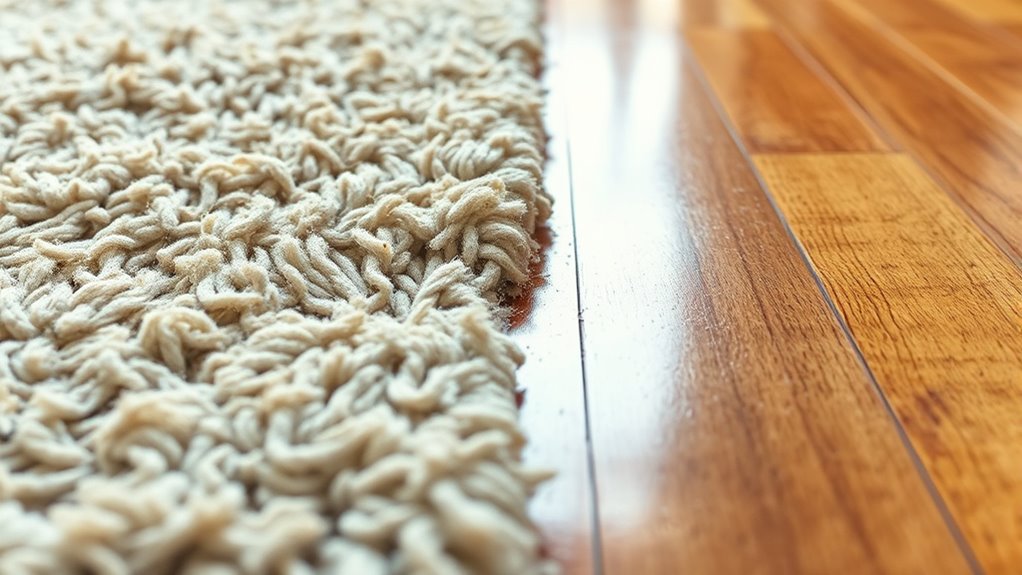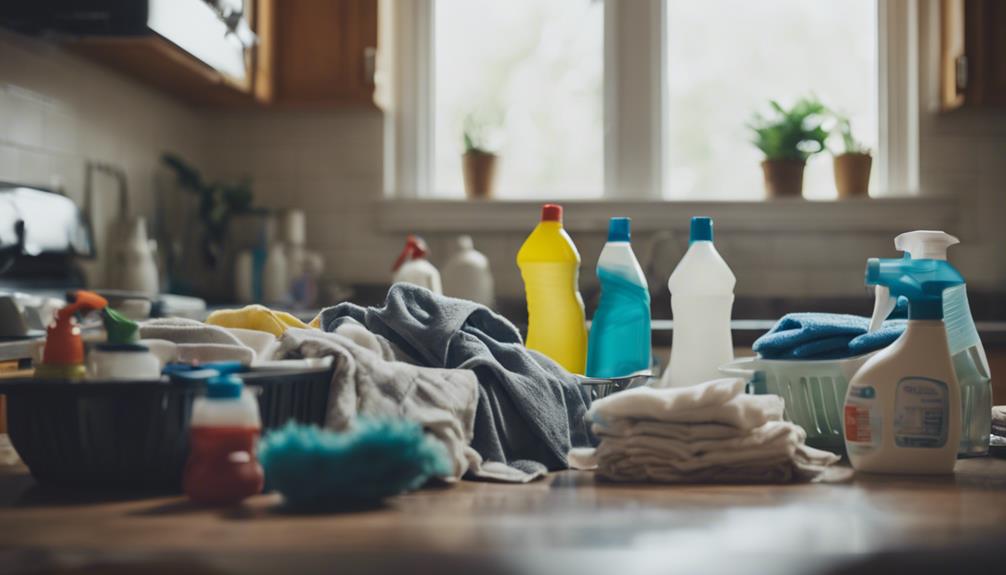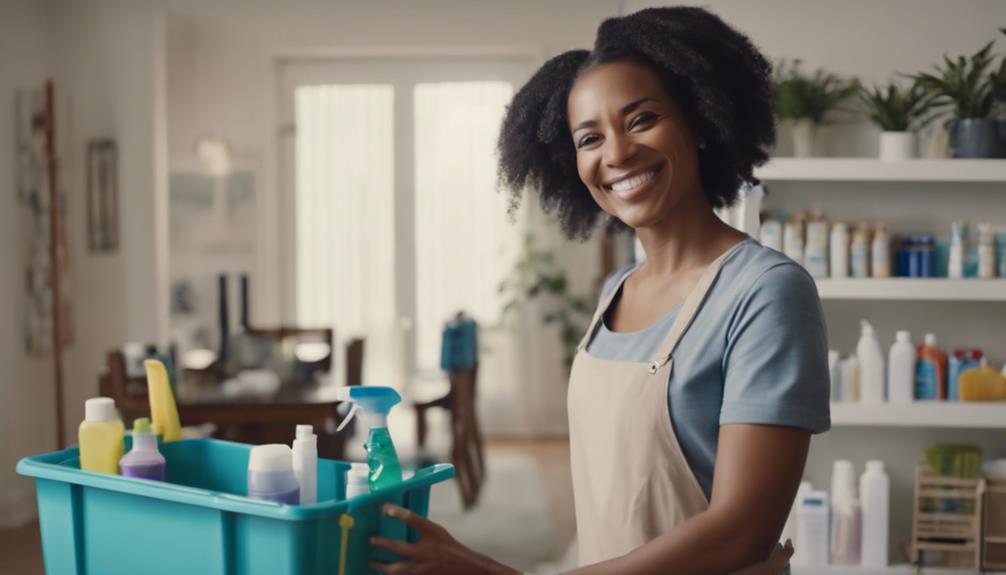Cleaning your carpets and hard floors properly isn’t just about looks—it’s essential for their longevity, your indoor air quality, and your health. Hard floors need gentle routines, while carpets require regular vacuuming and deep cleaning to reduce allergens. Using the right methods prevents damage, minimizes pollutants, and saves you money in the long run. If you want to protect your home’s surfaces and improve your environment, understanding how cleaning choices matter will help you make smarter decisions.
Key Takeaways
- Carpets trap allergens and dust, requiring regular vacuuming and deep cleaning to improve indoor air quality.
- Hard floors are easier to clean and less prone to staining, but need proper maintenance to prevent damage.
- Using appropriate cleaning methods extends the lifespan of both carpets and hard floors, reducing replacement costs.
- Neglecting cleaning can lead to surface deterioration, costly repairs, and health issues related to allergens and bacteria.
- Choosing eco-friendly, suitable cleaning routines supports healthier indoor environments and environmental sustainability.
Understanding Different Flooring Types and Their Benefits

Understanding the different flooring types and their benefits helps you choose the right cleaning methods for each surface. Your flooring material influences how you should maintain it daily and long-term. For example, hardwood floors require gentle cleaning routines to prevent scratches and warping, while tile floors can handle more robust cleaning methods like scrubbing and steam cleaning. Carpets trap dust and allergens, needing regular vacuuming and occasional deep cleaning, whereas vinyl and laminate floors are easier to wipe down with minimal effort. Recognizing these differences guarantees you don’t damage your floors or reduce their lifespan. Adapting your maintenance routines to each flooring material keeps your surfaces looking their best and extends their durability, saving you time and money over the years. Proper cleaning also contributes to mental well-being by creating a clean and calming environment in your home.
The Impact of Cleaning Methods on Floor Longevity

The cleaning methods you choose directly affect the lifespan of your floors. Proper techniques preserve surface integrity, enhance stain removal, and maintain slip resistance. For example, aggressive scrubbing can damage flooring, while gentle cleaning extends durability. Here’s a quick comparison:
| Method | Effect on Floor Longevity |
|---|---|
| Wet mopping with harsh chemicals | Can degrade surface and reduce slip resistance over time |
| Soft sweeping & mild cleaners | Protects finish, maintains stain removal efficiency, and prolongs lifespan |
Using the right approach ensures your floors stay looking new longer, avoiding premature wear and costly repairs. Remember, gentle cleaning that emphasizes stain removal without compromising slip resistance is key to maximizing your floors’ lifespan. Regular maintenance and understanding floor surface types can further help in selecting the appropriate cleaning methods.
How Cleaning Choices Affect Indoor Air Quality

Your cleaning choices directly influence the indoor air quality in your home. Poor cleaning methods can increase indoor pollution and airborne allergens, affecting your health. Consider these key points:
- Using harsh chemicals can release volatile organic compounds (VOCs), worsening indoor pollution.
- Regularly vacuuming carpets helps remove airborne allergens but choosing the right vacuum matters.
- Hard floors, when cleaned with eco-friendly products, minimize dust and reduce airborne allergens in the air.
- Incorporating Italian cuisine techniques, such as using natural ingredients and gentle cleaning methods, can also contribute to a healthier indoor environment by reducing chemical residues.
Cost Implications of Proper Floor Maintenance
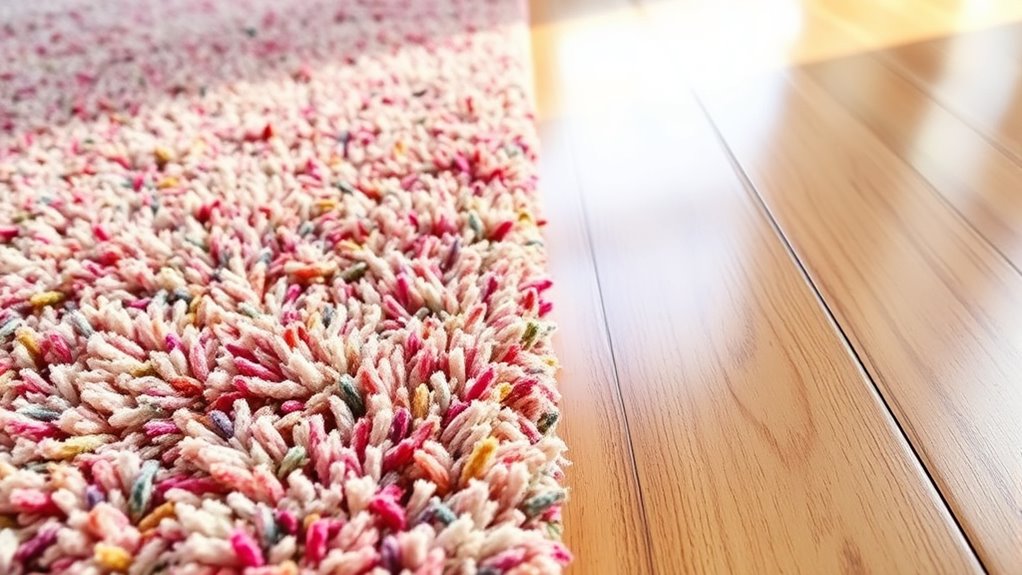
Maintaining your floors properly can save you money in the long run, but it’s important to contemplate costs like repair expenses and cleaning supplies. Hard floors often require fewer repairs and less frequent replacements, reducing overall expenses, while carpets may need more frequent attention. Additionally, choosing the right cleaning equipment, such as paint sprayers, can improve efficiency and reduce wear and tear on your flooring. Understanding these cost implications helps you make smarter choices for your budget and flooring type.
Long-term Repair Expenses
Proper floor maintenance can substantially impact your long-term repair expenses, as neglecting small issues often leads to costly repairs down the line. Choosing the right vacuum affects how well you remove dirt and prevent damage, especially to carpets. Regular vacuum selection helps avoid deep-seated debris that can wear down fibers over time. Additionally, timely stain removal prevents permanent discoloration, reducing the need for expensive repairs or replacements. Incorporating color accuracy considerations into maintenance routines can also help monitor and preserve the visual integrity of your flooring over time.
Consider these key points:
- Consistently using the appropriate vacuum minimizes fiber damage and prolongs carpet life.
- Prompt stain removal prevents permanent damage, lowering repair costs.
- Addressing minor issues early avoids larger, costly repairs later on.
Investing in proper maintenance now saves you money and extends your flooring’s lifespan.
Cleaning Supply Costs
Investing in quality cleaning supplies can substantially impact your overall floor maintenance costs. A diverse range of cleaning products allows you to effectively target specific flooring types, reducing the need for multiple purchases and minimizing waste. While high-quality supplies may seem costly upfront, they often last longer and deliver better results, lowering long-term expenses. Additionally, considering supply chain sustainability ensures you’re choosing eco-friendly options that support responsible manufacturing and reduce environmental impact. This not only benefits the planet but can also prevent future costs associated with damaged or prematurely worn floors caused by inferior or incompatible cleaning products. By prioritizing product diversity and sustainable sourcing, you optimize your cleaning routine, ultimately saving money and supporting eco-conscious practices. Furthermore, the use of the right home theatre projector can enhance your viewing experience, making your space more enjoyable and reducing the need for frequent replacements or repairs.
Replacement Frequency Rates
Using high-quality cleaning supplies not only improves the appearance and longevity of your floors but also influences how often they need replacing. Proper maintenance schedules extend the replacement cycle, saving you money over time. To optimize this, consider these factors:
- Regular cleaning prevents dirt buildup, reducing wear and tear.
- Adhering to recommended maintenance schedules minimizes damage, prolonging lifespan.
- Addressing issues early avoids costly repairs or premature replacements.
- Implementing appropriate cleaning techniques tailored to your flooring type can further enhance durability.
Hard floors generally have a longer replacement cycle than carpets, which can wear out faster without consistent care. By following a disciplined maintenance routine, you can delay the need for replacements and reduce costs. Remember, neglecting proper upkeep shortens replacement frequency rates, leading to higher expenses and more frequent renovations.
Allergens and Hygiene: Keeping Your Home Safe

While both carpets and hard floors can harbor allergens, choosing the right cleaning method is vital for maintaining a healthy home. Carpets tend to trap pet dander, dust mites, and other allergens, making thorough cleaning indispensable. Regular vacuuming helps with pet stain removal and reduces allergy triggers, but deep cleaning maintains hygiene. Hard floors, on the other hand, are easier to sanitize and don’t trap allergens as easily. When cleaning carpets, be mindful of color preservation; harsh chemicals can damage fibers and discolor your rug. Using gentle, effective cleaning solutions ensures allergens are removed without compromising your carpet’s appearance. Additionally, air purifier technology can further improve indoor air quality by removing airborne allergens and pollutants. Ultimately, maintaining hygiene on both surfaces keeps your home safer and minimizes allergy symptoms for everyone.
The Environmental Footprint of Cleaning Products and Techniques
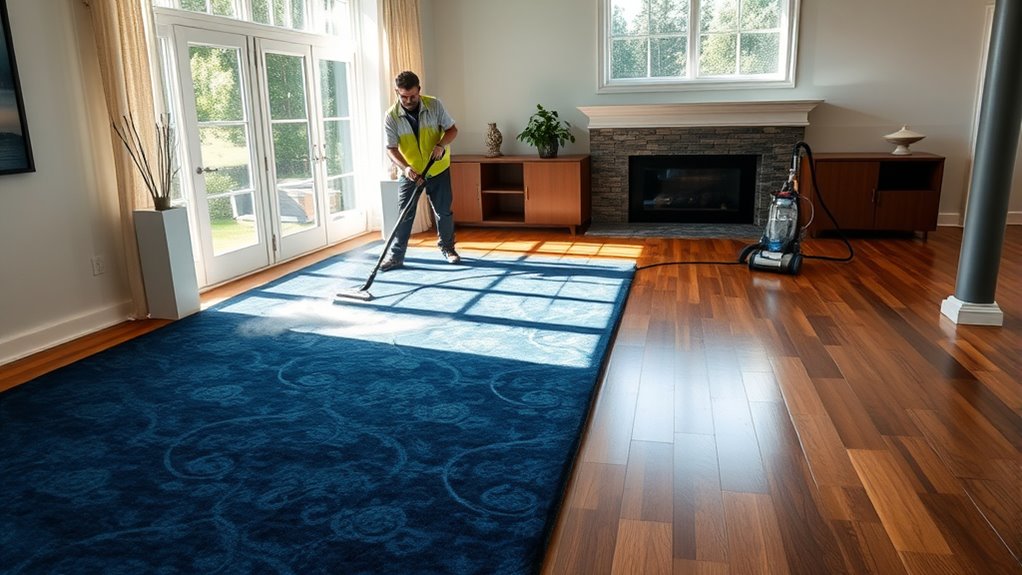
Choosing eco-friendly cleaning products and techniques can considerably reduce your home’s environmental impact. By switching to biodegradable cleaners and adopting eco friendly techniques, you minimize harmful waste and conserve resources. Here are three ways to make a difference:
Switch to biodegradable cleaners and eco-friendly methods to reduce waste and protect our environment.
- Use biodegradable cleaners that break down naturally, reducing pollution and protecting waterways.
- Opt for DIY solutions like vinegar and baking soda, which are effective and eco-conscious.
- Employ cleaning methods that limit water and energy use, such as steam cleaning or microfiber cloths.
- Selecting the right dog names can also reflect your eco-conscious values and personality, adding a personal touch to your lifestyle.
These choices help lower your carbon footprint and reduce chemical runoff. Focusing on environmentally friendly techniques not only benefits the planet but also creates a healthier indoor environment for you and your family. Small changes can lead to a significant positive impact.
Tips for Selecting the Right Cleaning Routine for Your Floors
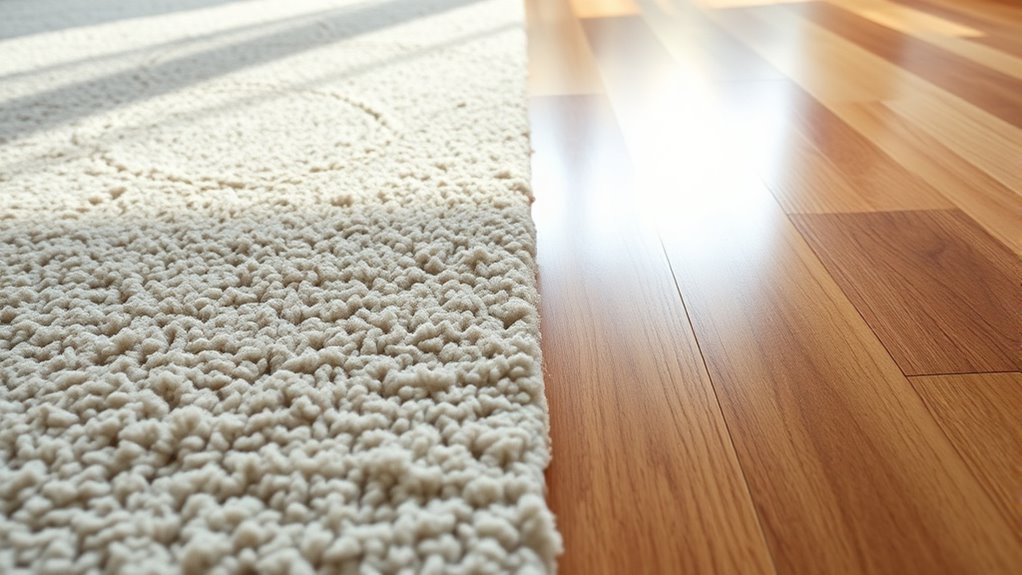
Choosing the right cleaning routine depends on your floor’s material, so make certain your methods won’t cause damage. Consider how often and when you clean to keep your floors looking their best without unnecessary wear. Using effective, compatible cleaning products ensures cleanliness while protecting your floors’ integrity. Additionally, understanding specific flooring materials can help you select the most suitable cleaning techniques to maintain durability and appearance.
Surface Material Compatibility
Selecting the right cleaning routine depends heavily on understanding your floor’s surface material. Different materials require specific care to avoid damage and ensure longevity. For example, surface material compatibility varies between hardwood, tile, and carpet, affecting your cleaning choices. Also, consider your flooring installation methods, as some adhesives or finishes may be sensitive to certain cleaners. To get started:
- Match cleaning products to your floor type—use gentle, pH-neutral solutions for hardwood and tile, but avoid harsh chemicals on delicate surfaces.
- Check manufacturer recommendations based on your flooring installation methods—some adhesives or finishes may require special care.
- Test cleaners in small inconspicuous areas first to prevent discoloration or damage.
- Remember that surface material compatibility is essential for maintaining your floors’ appearance and durability over time.
Frequency and Timing
Understanding how often and when to clean your floors can prevent damage and keep them looking their best. For daily routines, hard floors like tile or wood benefit from sweeping or vacuuming daily to remove dirt and debris. Carpets, on the other hand, should be vacuumed at least twice a week. Seasonal scheduling plays a role in deep cleaning—spring and fall are ideal times for thorough cleaning to remove accumulated dust and allergens. Adjust your routine based on foot traffic and environmental factors; high-traffic areas may need more frequent attention. By establishing a consistent schedule, you prevent grime buildup and extend your floors’ lifespan. Proper timing guarantees your cleaning efforts are effective without causing unnecessary wear or damage. Regular maintenance supports your goal of creating a calm, functional, and beautiful home environment.
Effective Cleaning Products
Using the right cleaning products is essential to protect your floors and achieve effective results. Choosing the correct cleaning tools and storage solutions guarantees your routine is efficient and safe. Consider these tips: 1. Select cleaning products specifically formulated for your floor type—gentle for hardwood, heavy-duty for carpets. 2. Invest in versatile cleaning tools that suit both surfaces, like microfiber mops and appropriate vacuums. 3. Store cleaning supplies in organized storage solutions to keep your tools accessible and prevent cross-contamination. 4. Be mindful of the filtration systems in your vacuum cleaners, such as HEPA filters, to effectively trap allergens and fine dust. Using the right products prevents damage and prolongs your floors’ lifespan. Always read labels and follow manufacturer instructions for best results. With the proper cleaning tools and smart storage, you’ll maintain floors that look great and last longer.
Long-Term Health Benefits of Maintaining Clean Floors
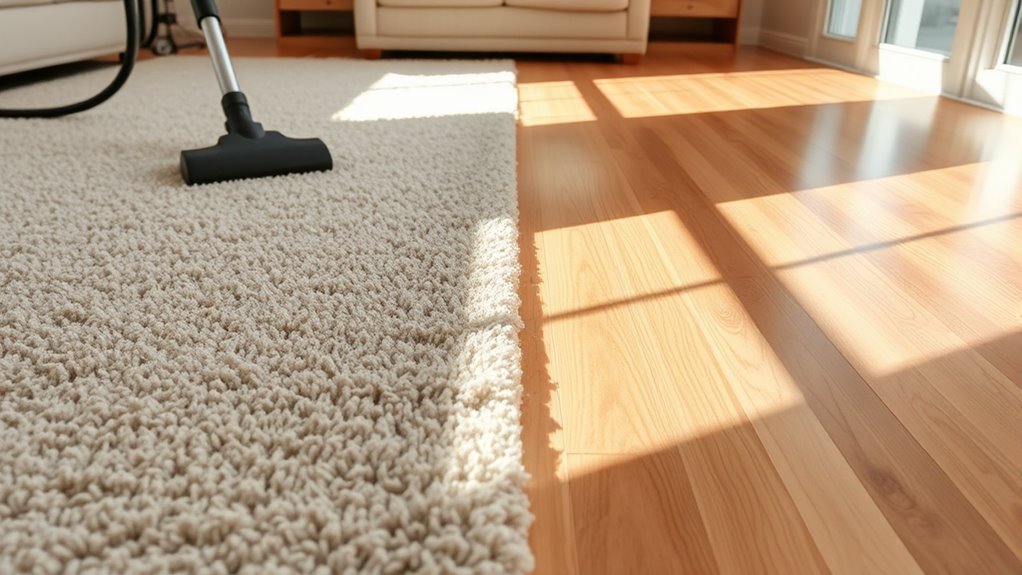
Maintaining clean floors consistently can considerably benefit your long-term health by reducing exposure to allergens, bacteria, and dust. When you keep floors free from dirt, you minimize airborne pollutants that can trigger allergies and respiratory issues. Regular cleaning also curbs microbial growth, which can develop in hidden areas, leading to infections or illnesses over time. Hard floors are easier to keep disinfected, preventing the buildup of bacteria and mold. Carpets, if not cleaned properly, can trap allergens and microbes, worsening indoor air quality. By investing in consistent cleaning routines, you create a healthier environment, reduce the risk of chronic respiratory problems, and promote overall well-being. Incorporating proper cleaning methods can further enhance these health benefits. Clean floors are a simple but effective way to safeguard your health for years to come.
Frequently Asked Questions
How Often Should I Professionally Deep Clean My Carpets or Floors?
You should professionally deep clean your carpets and floors every 12 to 18 months, depending on your cleaning frequency and maintenance schedule. Regular vacuuming and spot cleaning help extend this interval. If you have pets, allergies, or high foot traffic, consider more frequent deep cleans. Staying consistent guarantees your floors stay fresh, hygienic, and look their best, ultimately protecting your investment and creating a healthier living environment.
What Cleaning Techniques Are Safest for Children and Pets?
You should use pet safe cleaning and child friendly methods to keep your home safe. Opt for natural cleaning solutions like vinegar and baking soda, which are non-toxic and effective. Avoid harsh chemicals and strong disinfectants that could harm your pets or kids. Always read labels and choose products specifically designed for homes with children and animals. Regularly vacuum and mop to maintain a clean, healthy environment for everyone.
Can Improper Cleaning Damage My Flooring Material Permanently?
If you don’t clean properly, you risk damaging your flooring permanently. Improper cleaning can weaken flooring durability and shorten its lifespan, making it look worn or cracked over time. You might think you’re maintaining it, but wrong techniques can erode its surface and compromise its integrity. To preserve cleaning longevity, always use suitable products and methods for your specific flooring type — neglect this, and your floors could suffer irreversible harm.
How Do Cleaning Products Affect Indoor Environmental Toxins?
Cleaning products can considerably impact indoor air quality by releasing chemical residues into the air. When you use harsh chemicals, they may linger on surfaces and become airborne, potentially causing respiratory issues or allergies. Properly choosing eco-friendly or low-toxicity cleaning agents helps reduce indoor air pollution. Regular ventilation also helps clear chemical residues, ensuring your indoor environment stays healthier and safer for everyone in your home.
Are Eco-Friendly Cleaning Options as Effective as Traditional Methods?
Yes, eco-friendly cleaning options are just as effective as traditional methods. Green cleaning and natural methods use plant-based ingredients and non-toxic products that tackle dirt and germs effectively. You can trust these options to clean your floors and carpets without exposing your home to harsh chemicals. By choosing natural methods, you guarantee a healthier environment while maintaining the cleanliness you need, making eco-friendly cleaning a smart choice for your space.
Conclusion
Choosing the right cleaning method for your floors isn’t just about appearance—it impacts your health, wallet, and environment. By understanding your flooring type and sticking to proper routines, you can extend your floor’s life and improve indoor air quality. Isn’t investing a little extra effort worth creating a safer, healthier home for you and your loved ones? Remember, small choices today lead to long-term benefits tomorrow.
